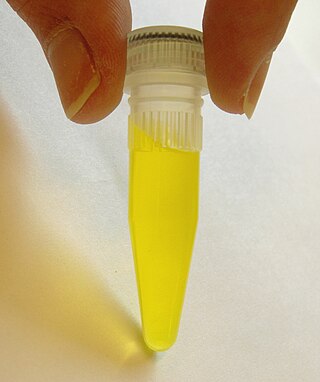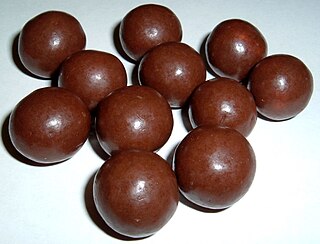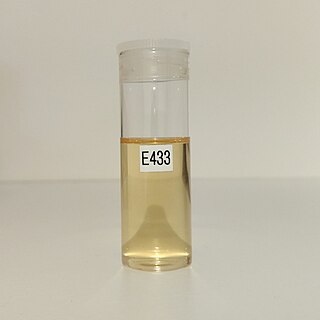
Food additives are substances added to food to preserve flavor or enhance taste, appearance, or other sensory qualities. Some additives have been used for centuries as part of an effort to preserve food, for example vinegar (pickling), salt (salting), smoke (smoking), sugar (crystallization), etc. This allows for longer-lasting foods such as bacon, sweets or wines. With the advent of ultra-processed foods in the second half of the twentieth century, many additives have been introduced, of both natural and artificial origin. Food additives also include substances that may be introduced to food indirectly in the manufacturing process, through packaging, or during storage or transport.
The International Numbering System for Food Additives (INS) is a European-based naming system for food additives, aimed at providing a short designation of what may be a lengthy actual name. It is defined by Codex Alimentarius, the international food standards organisation of the World Health Organization (WHO) and Food and Agriculture Organization (FAO) of the United Nations (UN). The information is published in the document Class Names and the International Numbering System for Food Additives, first published in 1989, with revisions in 2008 and 2011. The INS is an open list, "subject to the inclusion of additional additives or removal of existing ones on an ongoing basis".

E numbers, short for Europe numbers, are codes for substances used as food additives, including those found naturally in many foods such as vitamin C, for use within the European Union (EU) and European Free Trade Association (EFTA). Commonly found on food labels, their safety assessment and approval are the responsibility of the European Food Safety Authority (EFSA). The fact that an additive has an E number implies that its use was at one time permitted in products for sale in the European Single Market; some of these additives are no longer allowed today.

Surfactants are chemical compounds that decrease the surface tension or interfacial tension between two liquids, a liquid and a gas, or a liquid and a solid. The word "surfactant" is a blend of surface-active agent, coined c. 1950. As they consist of a water-repellent and a water-attracting part, they enable water and oil to mix; they can form foam and facilitate the detachment of dirt.

Food coloring, or color additive, is any dye, pigment, or substance that imparts color when it is added to food or drink. They can be supplied as liquids, powders, gels, or pastes. Food coloring is used in both commercial food production and domestic cooking. Food colorants are also used in a variety of non-food applications, including cosmetics, pharmaceuticals, home craft projects, and medical devices. Colorings may be natural or artificial/synthetic.

Carrageenans or carrageenins are a family of natural linear sulfated polysaccharides that are extracted from red edible seaweeds. Carrageenans are widely used in the food industry, for their gelling, thickening, and stabilizing properties. Their main application is in dairy and meat products, due to their strong binding to food proteins. In recent years, carrageenans have emerged as a promising candidate in tissue engineering and regenerative medicine applications as they resemble native glycosaminoglycans (GAGs). They have been mainly used for tissue engineering, wound coverage, and drug delivery.

Whoppers are malted milk balls with an artificial flavored "chocolatey coating" produced by The Hershey Company. The candy is a round ball about 3⁄4 inch (20 mm) in diameter. They are typically sold in various packaging options: either in a small cardboard candy box, in a larger box that resembles a cardboard milk carton, as the 'Fun Size' variety which is a tube-shaped plastic package sealed at the sides and contains twelve Whoppers weighing 21 grams, or as an even smaller variety in a tube containing three Whoppers weighing 6.8 grams.

Maltesers are a British confectionery product manufactured by Mars, Incorporated. First sold in the UK in 1937, they were originally aimed at women. They have since been sold in Europe, Australia, New Zealand, Canada, United States and Middle East. The slogan is "The lighter way to enjoy chocolate".

Polysorbates are a class of emulsifiers used in some pharmaceuticals and food preparation. They are commonly used in oral and topical pharmaceutical dosage forms. They are also often used in cosmetics to solubilize essential oils into water-based products. Polysorbates are oily liquids derived from ethoxylated sorbitan esterified with fatty acids. Common brand names for polysorbates include Kolliphor, Scattics, Alkest, Canarcel, Tween, and Kotilen.

Polysorbate 80 is a nonionic surfactant and emulsifier often used in pharmaceuticals, foods, and cosmetics. This synthetic compound is a viscous, water-soluble yellow liquid.
Polysorbate 20 is a polysorbate-type nonionic surfactant formed by the ethoxylation of sorbitan monolaurate. Its stability and relative nontoxicity allows it to be used as a detergent and emulsifier in a number of domestic, scientific, and pharmacological applications. As the name implies, the ethoxylation process leaves the molecule with 20 repeat units of polyethylene glycol; in practice these are distributed across 4 different chains, leading to a commercial product containing a range of chemical species.
Sorbitan monostearate is an ester of sorbitan and stearic acid and is sometimes referred to as a synthetic wax.

Sorbitan is a mixture of isomeric organic compounds derived from the dehydration of sorbitol and is an intermediate in the conversion of sorbitol to isosorbide. Sorbitan is primarily used in the production of surfactants such as polysorbates; which are important emulsifying agents, with a total annual demand of more than 10,000 tons in 2012.
Sorbitan monolaurate is a mixture of esters formed from the fatty acid lauric acid and polyols derived from sorbitol, including sorbitan and isosorbide. As a food additive, it is designated with the E number E493.
Sorbitan monooleate is a food additive with the E number E494.
Sorbitan monopalmitate (SMP) is a food additive, permitted by the EU. It is entry E495 in the E number list of permitted food additives. It is also known under the trade name Span 40.










